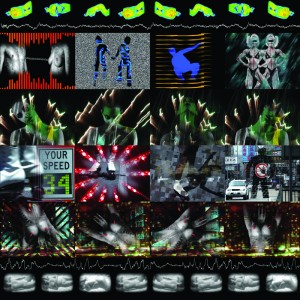Lynne Sanderson is a new media artist whose works have been exhibited widely, including ISEA95 Montreal, MTV Australia, MoMA NYC, Adelaide Biennial of Australian Art, Biennial of Electronic Art Perth (BEAP), Big Day Out and the front cover of Photofile. In between making art, she lectures in Visual Art at the University of South Australia.

A collection of stills from a VJ mix and a sleep session.
Lynne Sanderson’s first big solo show, …Mutant!…, was in 1998. It caused a gratifying degree of stir – more than expected for so young an artist and the stir was in a particular sector of the audience: the show slewed the usual demographic towards the younger end and the new-media savvy. …Mutant!… had some endearing levels of clunk to it – but basically it was recognised as advanced work in hybrid new media: an essay in the possibilities of imagery, sound and programming, and the exploration of themes of rhythmic rhyzomic mutancy.
Sanderson graduated from art school already feeling that the gallery art scene was not enough for her. There the highest valuations went to ponderously philosophical art-informel installation – punky grunge versions of Dürer’s Melancholia fed though the Krauss/Bois machine. Sanderson began working with sound and music events, developing inventively and interactively spectacular concepts, working for clubs, the Big Day Out etc.
Sanderson spends a lot of time with the sleepy, the sleeping and the sleepless, working at The Centre for Sleep Research at the Queen Elizabeth Hospital, waking subjects when the signs are right – basically to demand “Tell me your dream”.
A standardised system is used – breaking dreams into components and their variations (dreams in rooms, dreams outside, dreams of movement) – and their subdivisions (private space? familiar or not? public space? journeys by foot? running/walking? easily/with difficulty? pursued/pursuing?): thus a typology of plots and scenarios, and of emotional colourings (sad, happy, relaxed, excited, calm).
Imagery can be correlated with emotional register – the one affecting the other. This nexus, Sanderson reasons, should work in either direction: the dream producing emotion – an emotion inducing the apposite dream. (Such thinking has long been the basis of colour therapy – viz. early Roy de Maistre’s schemes to produce restful, calm wards for the shell-shocked.) The imagery employed is “reminiscent of early German Expressionist silent films” says Sanderson, but as if they had met David Lynch “in a music video context.”
Sanderson is developing interactive pieces that sense a physical presence and offer sound and visuals to meet the subject’s state and to alter it. This is done by employing the affective properites of sound-and-imagery and reading the subject’s real-time bio-date (skin conductive response, temperature etc). Sanderson will move us from the text-dependency of most current interactive technology (withdrawal? deposit? – credit or savings? – receipt?) towards a less verbal, more body-kinetic interaction.
The project will eventuate in the work Lucid Touch – a result of Sanderson’s V-Jing activities and her research into emotional states, somatic states and dream imagery. Sanderson’s V-J work has seen some interesting programs and patches developed allowing improvisation on the spot – in tune with, or contrapuntally against, the music and dance-floor ‘feel’. Most of the punters will have figured that they were merely at a wondrously right but pre-programmed light show. But no – Sanderson is riffing on or against, the music and the vibe. Still in development, Lucid Touch (watch for it in SALA Week 2005) would eventually make possible a public art work in which, by holding a sensor and watching a screen (feeling warmth and the tell-tale vibration which signals a presence within), we will find ourselves dancing psychically with the ‘ghost in the machine’: the machine leading, but able to be led as well. And the ensuing collaboration will be visible – in the form of imagery, sound and sequencing.
Ken Bolton
Ken Bolton is a poet and works at the Experimental Art Foundation in Adelaide. His most recent collection Untimely Meditations appeared from Wakefield Press in 1997, as will his next, At the Flash & At the Baci, in 2005.
Read More
http://www.myspace.com/vj_sustenance
 This work is licensed under a Creative Commons Attribution-NonCommercial-ShareAlike 2.5 Australia.
This work is licensed under a Creative Commons Attribution-NonCommercial-ShareAlike 2.5 Australia.






